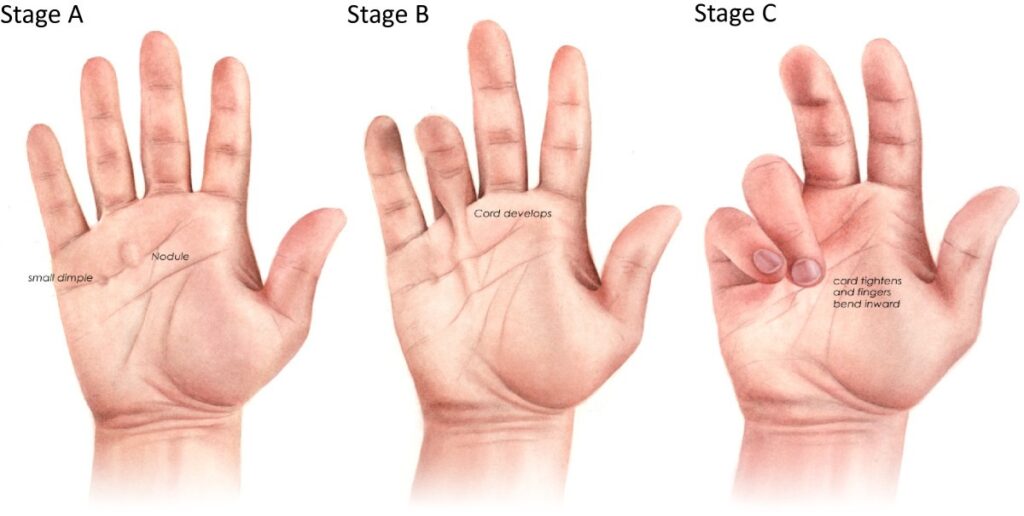
Dupuytren’s contracture is a connective tissue disorder which impacts the palmar fascia and can lead to flexion contractures of the metacarpophalangeal (MCP) and proximal interphalangeal (PIP) joints (Cooper, 2018).This typically takes years to develop eventually resulting in a the fibrous cord pulling the fingers down making it very difficult to extend completely. Typically effects men of Norther European descent more than women (10:1) (Cooper, 2018).
Areas Affected:
- Palmar Fascia
- Subcutaneous tissue of the palm
- Overlying dermis
Symptoms
- Thickening of skin on palm
- Thickening progresses to appear as small nodules (puckered or dimpled skin)
- Firm lumps sensitive to contact.
- Cords could develop later from palm to the base of fingers.
- As cords continue to progress and tighten, fingers are pulled into flexion
Common Associations with Dupuytren’s contracture
- Diabetes
- Tobacco use
- Alcohol consumption
- Genetics/family history
- Age (common after 50)(Mayoclinic.org, 2018)
Treatments for Dupuytren’s contracture
The most common and effective treatments are associated with removing or breaking apart the cords associated with pulling your fingers into flexion. Sometimes treatment is not always necessary, if the nodules are the only things present and there’s no signs of flexion, it’s best to wait and see if the symptoms progress further before seeking treatment. If the symptoms are interfering with your ability to perform daily activities, then treatment should be considered.
Common treatments include
- Collagenase intervention (Xiaflex) has become very popular and is minimally invasive. This enzyme is injected into the affected tendon/cords to break down and weaken the fibers, and a few days later, the doctor will manipulate the fingers into flexion breaking the tendons free allowing the fingers to extend and straighten.
- Dupuytrens Release (Surgery) is more invasive, recovery time is longer, but it is a more comprehensive procedure that allows the surgeon to remove the fibrous tissue completely.
- Radiation therapy works best when utilizing during the early stages of Duputrens (nodules and beginnings of cord formation (1-5 degrees of contracture). This utilizes radiation to slow the growth rate of the fibroblasts and myofibrilblasts allowing the nodules to stop progressing and potentially soften (dupuytren-online.info, 2019). This procedure is great for early intervention.
- It’s always best to consult your specialist to determine which treatments are best for you.
References
- Cooper, C. (2014). Fundamentals of hand therapy: Clinical reasoning and treatment guidelines for common diagnoses of the upper extermity (2nd edition). Elsevier Mosby.
- Mayo Clinic Staff. (2018, October 12). Dupuytren’s contracture. Retrieved August 23, 2020, from https://www.mayoclinic.org/diseases-conditions/dupuytrens-contracture/diagnosis-treatment/drc-20371949
- Radiation therapy (radiotherapy) of Dupuytren’s and Ledderhose Disease. (2019, March 25). Retrieved August 23, 2020, from https://www.dupuytren-online.info/radiation_therapy.html
- Syed, F., Thomas, A. N., Singh, S., Kolluru, V., Emeigh Hart, S. G., & Bayat, A. (2012). In vitro study of novel collagenase (XIAFLEX®) on Dupuytren’s disease fibroblasts displays unique drug related properties. PloS One, 7(2), e31430. https://doi.org/10.1371/journal.pone.003143
Due to the nature of this diagnosis stretches and modalities are more beneficial for post intervention conditions. Consult your doctor first.
